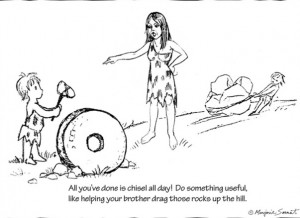
How many times have you logged into Facebook with the intention of just quickly checking the News Feed when you notice a quiz? Intrigued, you click the link and have now been sucked into a quiz, which you’ll then share on Facebook causing a portion of your friends to do the same. BuzzFeed got you once again.
Within the last year, BuzzFeed has become the most dominant force when it comes to generating viral content. For example, the site skyrocketed its traffic 855 percent between September 2012 to September 2013 after Facebook altered its News Feed. While there has been some questionable methods attached to reaching this level of success – liking paying for ads on Facebook and plagiarism – the site still has had a remarkable run. Whether you like it or not.
BuzzFeed was founded by Jonah Peretti in 2006 as an initiative to test, track, and create viral content. Peretti is one interesting character. He graduated from MIT, taught computing in New Orleans, co-founded the Huffington Post with Arianna Huffington, Kenneth Lerer, and Andrew Breitbart, has dyslexia and became a viral sensation himself, following email exchanges with Nike. Today, he is the CEO of one the world’s most well-known media and technology companies, which produces an average of 378 posts a day that has raised 46 million in venture capital from the Hearst Corporation, RRE, Lerer Ventures, and Japan’s SoftBank.
But, what exactly is BuzzFeed? Isn’t it just that site that creates quizzes and shares pictures of adorable animals? Yes and no. It’s actually a site that handles a wide range of tasks.
For starters, it can be a pop-culture where visitors can vote on the articles by using Badges like “LOL”, “WIN”, “OMG”, “CUTE”, “TRASHY”, “FAIL”, “WTF”. It can also be a serious news site with in-depth articles written and edited by people who used to work for Politico and NBC. And, it can be an organization that brands spend big money on to make their content go viral.
No matter the project that BuzzFeed is currently working on, there’s no denying it has revolutionized online advertising by embracing social, content-driven publishing. And, even if you loathe BuzzFeed, you still have to respect that. Plus, you can actually learn a lot from BuzzFeed. Consider the following 10 ways to get traffic like BuzzFeed. And, no. You won’t have to hand over your hard-earned cash to Facebook.
1. Obsessively Test
Believe it not, there’s actually a lot of effort put into the content that BuzzFeed publishes. There’s not a group of 5 or 6 people lounging around and gathering collections of sleeping animals that they assume we will instinctively click. There’s actually a formula in place: R = βz.
The R stands for the amount of traffic that the post will reach, z is the number of people who actually view the post, and β is how likely the post will go viral. Of course, this sounds obvious to anyone who has created content at some point. Most of us are aware that a post will spread like a wildfire because of the amount of places that is has been linked to.
While luck is certainly a factor, BuzzFeed invests a fair amount of resources into trying to figure this formula out. And, the best way to do that is experimenting with simple A/B testing and analytics. For anyone who has dabbled in the world of content marketing, you already know how important a standard A/B test is. For those unfamiliar with this test, it’s usually used to compare two different versions of a website to see which one does better with traffic. How does Buzzfeed use A/B testing and analytics?
According to Wired (UK) BuzzFeed uses a machine that analyzes each piece of content that they publish. These pieces all have their own dashboard which allows the BuzzFeed team to examine how the content went viral, comparing the “seed views” from the site to the scalable “social views.”
Understanding where your audience is coming from and the type of content they’re sharing, can help you predict how to increase traffic to your site and throughout your social media channels. And the best way to do that is by compulsively testing.
2. Have a Long Term Goal
While most of us have been familiar with BuzzFeed in some way for a couple of years now, it has really taken off within the last year. In fact, by the end of 2013, BuzzFeed was seeing a record number of visitors per month. In November, for example, it had over 130 million unique visitors, which was an astonishing 350 percent increase YOY. It also shouldn’t’ be surprising that most of the referrals came from Facebook. While for many of us outsiders we think BuzzFeed came out of nowhere, this was all planned out.
In an email to employees and investors from in 2012, Jonah Peretti stated:
When you compare web publishing today with what Hearst and Conde Nast built in the last century, it is clear that online publishing has a long, long way to go. As sites like Facebook and Twitter mature, the moment is right to build a defining company for a world where content is distributed through sharing and social media instead of transitional print and broadcast channels. Why shouldn’t we be one of the companies that builds this future?
Two years later, BuzzFeed has shown that they can be one of these companies who are building the future. Peretti and company had a long-term goal. They realized the advantages and urgency of using platforms like Facebook. Now, you can’t even log into to Facebook without someone sharing a quiz compliments of BuzzFeed. By the way, Peretti still feels that focusing on 3-5 years out is more productive than just the “short-term vanity metrics.”
In other words, plan and build for the future. Don’t worry about how many “Likes” your content did or didn’t get today. You’re in it for the long haul, so learn from your mistakes and make the adjustments for going forward.
3. It’s About People
As a general rule, people are more inclined to share information that speaks to them. In other words, they’re looking for something that has a human element to it. When you present something that is interpersonal, it starts a conversation. If you have an article like “21 Things A Guy Quickly Learns After Moving In With His Girlfriend For The First Time,” couples will gladly share that because it reminded them of what it was like when they first moved in with each other. Even if they disagree with the list, they still might share just to point out that they were nothing like that.
However, the content should also be authentic. Going back to the article mentioned above, perhaps it could be stated that this was the personal experience of the author. Suddenly, that list has a little more of a meaning because it came from a real person.
4. Keep It Short
During an interview with Both Sides of The Table, Jon Steinberg, president of Buzzfeed, stated content has to be short. How short? Videos for example, should be around 30 seconds because most people don’t have the attention or time to watch a 5-minute long clip. The same could also be said about images and written articles – even though this piece is running a bit long.
Overall, people want to get right into the point of your content. And, when there’s a clear call to action that is easily and quickly digestible, they will be more inclined to share that content. This explains why GIFs, inforgraphs, and lists are commonly shared. They capture emotions or present information in a format that in a rapid format.
5. Build a Community
People want content that they can engage with, not just consume. This is why all those quizzes you see on Facebook from BuzzFeed are so popular. People want to be in on the fun and want their network to join in as well.
But, it’s just not about fun and games all the time. Another part of building a community is giving people to react and comment. Making sure that you allow people to comment on your content with something like Disqus is a big deal. A solid comment section increases your chances of having a viral blog.
6. Forget About Pageviews
Have you ever clicked on a page because there was a list that caught your eye only to get duped into flipping through 10 pages of content? Chances are you won’t make it through the entire list. While you may increase the amount of page views on your site, people are less likely to digest and share content that is spread across multiple pages. As you know, this will prevent your content from going viral, which definitely won’t increase traffic.
7. Give People Something That They Want to Share
The best way to increase your traffic is by having others share your content. But, you already knew that. So, ask yourself this question…honestly. Which piece of content would you be willing to share on your social network outlets; “The Definitive Ranking of Girl Scout Cookies,” or “The Definitive Ranking or Jenna Jameson Films?” We’re pretty sure that your mom would love to read that post you just shared about an adult entertainer.
Whenever a person is sharing content, they’re also putting their reputation on the line. If they feel ashamed to pass your content around, then what was the purpose of creating it in the first place? Sure, you may find a niche and a certain amount of people who aren’t embarrassed. But, if you want to reach the masses, provide content people want to pass around.
8. People Can’t Get Enough of Lists and Images
Here’s another familiar topic that’s been explored countless times before. But, as long as people keep clicking and sharing content that consists of lists and images, we’ll keep mentioning it.
People are attracted to lists for several reasons. For starters, lists bring order to chaos and can help us organize the mayhem surrounding us all. Also, lists can help us remember things (why else do you make a shopping every week?), are easy to digest and are finite. Finally, lists can be meaningful for a lot of people. So, when BuzzFeed publishes something like “15 Surprising Facts About What Dog Behaviors Actually Mean,” almost every dog owner and animal lover is going to click on that article.
As for images, just remember that most people can’t view videos at work. So, images have a better chance of going viral.
9. Be Positive
We’ve all fallen in the trap of being negative or sarcastic sometimes. But, BuzzFeed has this really awesome “no-haters policy” that should be embraced by more people. For example, when BuzzFeed publishes “Mary Lambert’s Tips For Staying Positive (Even On Really Bad Days)” that’s something a lot of people would enjoy after a long day at the office or just when they’re having “one of those” days. Because they enjoyed something uplifting, they will be more than glad to share it with others.
However, that doesn’t mean that it’s always rainbows and unicorns. Peretti explains that you can still be critical. The difference is being critical isn’t just writing a couple thousand words on why you just saw the worst movie of all-time. Instead, BuzzFeed will examine the conditions of military hospitals in Afghanistan.
It may not always be a bright ray of sunshine, but people are looking for content that isn’t mean-spirited just to be perceived as ‘cool’ or better than someone else.
10. Have an Enticing Headline
This is an area that is constantly revisited, but it’s vital. So we’ll keep beating that poor old dead horse. But, why do titles really matter?
There have been some statistics that have shown that on average, 8 out of 10 people will read the headline copy. However, only 2 out of 10 will continue reading the text. By having a headline that is compelling, catchy and offers a call to action, you’re improving your odds in having more people read your content. And, if people actually like what you have published, the more likely they will be to share it with others.
Have you learned how to get more traffic from BuzzFeed? If so, what did you learn and did it work?
Featured Image Credit: Buzzfeed Facebook Page

Albert Costill
Read more on Search Engine Journal
(1394)
Report Post



